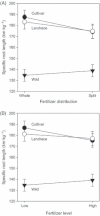Evolution of root plasticity responses to variation in soil nutrient distribution and concentration
- PMID: 23346229
- PMCID: PMC3552402
- DOI: 10.1111/j.1752-4571.2012.00263.x
Evolution of root plasticity responses to variation in soil nutrient distribution and concentration
Abstract
Root plasticity, a trait that can respond to selective pressure, may help plants forage for nutrients in heterogeneous soils. Agricultural breeding programs have artificially selected for increased yield under comparatively homogeneous soil conditions, potentially decreasing the capacity for plasticity in crop plants like barley (Hordeum vulgare). However, the effects of domestication on the evolution of root plasticity are essentially unknown. Using a split container approach, we examined the differences in root plasticity among three domestication levels of barley germplasm (wild, landrace, and cultivar) grown under different concentrations and distribution patterns of soil nutrients. Domestication level, nutrient concentration, and nutrient distribution interactively affected average root diameter; differential root allocation (within-plant plasticity) was greatest in wild barley (Hordeum spontaneum), especially under low nutrient levels. Correlations of within-plant root plasticity and plant size were most pronounced in modern cultivars under low-nutrient conditions. Barley plants invested more resources to root systems when grown in low-nutrient soils and allocated more roots to higher-nutrient locations. Root plasticity in barley is scale dependent and varies with domestication level. Although wild barley harbors a greater capacity for within-plant root plasticity than domesticated barley, cultivars exhibited the greatest capacity to translate within-plant plasticity into increased plant size.
Keywords: Hordeum spontaneum; Hordeum vulgare; artificial selection; barley; evolution of plasticity; plant domestication.
Figures


References
-
- Aanderud ZT, Bledsoe CS, Richards JH. Contribution of relative growth rate to root foraging by annual and perennial grasses from California oak woodlands. Oecologia. 2003;136:424–430. - PubMed
-
- Adams MA, Bell TL, Pate JS. Phosphorus sources and availability modify growth and distribution of root clusters and nodules of native Australian legumes. Plant Cell and Environment. 2002;25:837–850.
-
- Badr A, Muller K, Schafer-Pregl R, El Rabey H, Effgen S, Ibrahim HH, Pozzi C, et al. On the origin and domestication history of barley (Hordeum vulgare. Molecular Biology and Evolution. 2000;17:499–510. - PubMed
-
- Basak SL, Chaudhuri BB. Genetic variation and phenotypic plasticity of roots in two cultivated species of jute (Corchorus olitorus L. and C. capsularis L.) Biologia plantarum. 1967;9:292–300.
-
- Bennett EM, Carpenter SR, Clayton MK. Soil phosphorus variability: scale-dependence in an urbanizing agricultural landscape. Landscape Ecology. 2005;20:389–400.
LinkOut - more resources
Full Text Sources
Other Literature Sources

